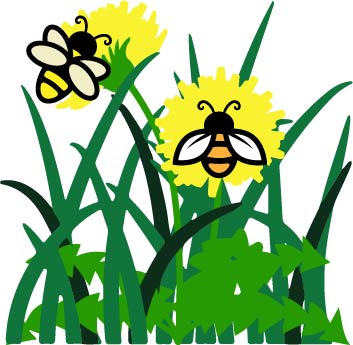Opinion: Our Suburban Lawns Are Lame
Fixing the pollinator problem: eliminating mowing and chemical usage
As we approach late spring and early summer in Wisconsin, plenty of suburban homeowners prepare for the warm weather and sunny days by dusting off the lawnmower and grabbing some bug and weed killers from the local hardware store to start their yearly lawn care routines.
However tempting these practices may be at first glance, most of these common lawn maintenance strategies fail to care for one crucial contributor to plant life: pollinators.
Pollinators like ants, butterflies and, most notably, the bee assist in the process of fertilization for plants by transporting pollen from the male part of one plant to the female part of another plant. The beloved pollinator plays a heavy role in abundant agriculture, productive gardening and healthy ecosystems.
In a 2016 report, the Food and Agriculture Organization of the United Nations published reviews on the global range and health of pollinators. According to the findings, nearly 75 percent of crops and 90 percent of wildflowers depended on animal pollination. Of these pollinators, 16.5 percent of vertebrate pollinators and over 40 percent of invertebrate pollinators risked global extinction at the time of the study.
There is good news, though. We are capable of helping our pollinators in our communities, and we bear the responsibility of enacting such changes. Two places where the common homeowner can, and should, change their practices to help pollinators are mowing and chemical usage. Let’s start with mowing.
So, the grass is getting a bit shaggy, and the dandelions are showing their yellow manes. There’s an easy solution: pull out the sharpened ceiling fan on wheels and cut all those plants down. But, in this process, we end up eliminating a large pool of plants, like dandelions and flowering clover, which our pollinators use to live and thrive.
Our lawn culture in America does not allow for a pollinator-friendly yard. This culture says grass ought to be short and homogenous, consisting of mostly the same kind of grass. This model of landscape, however, is flawed in many ways. Short-cut grasses have limited, shallow root systems which are vulnerable to droughts and dry spells and are usually unable to flower and enter the process of pollination. Homogenous lawns, having only one kind of grass, limit the range of viable pollinators.
Let’s move on to chemical usage. Using insecticides and herbicides to get rid of unwanted bugs or weeds is an effective treatment but risks harm to other life as well. In a 2021 study published by the British Ecological Society, researchers found that even herbicides without glyphosate, the typical active ingredient and regularly blamed killer in pesticides, produce a high mortality rate against bees.
This research is significant. Herbicides, even when labeled as “safe for bees,” still kill bees because the killing agent is not a single, precise ingredient. Other, unsuspected chemicals applied to, for instance, a flowering plant may be absorbed into the nectar and still pose a poisonous threat to the pollinator, nest or hive.
What are alternatives, then, to mowing and chemical usage, and how can we implement them?
For mowing, a homeowner can simply not mow their lawn. However, most municipalities have regulations on lawn height, and so leaving a yard to grow may result in fines and fees. We can mow, though, with the highest height setting on a mower to allow grasses and short plants to flower.
In May 2020, Lawrence University conducted a No Mow May experiment to review how not mowing can help flower and bee populations. In cooperation with the municipality and residents of Appleton, Lawrence University followed 435 residents’ yards to measure abundance of plant species, density of flowering plants, abundance of bee species and density of bee species.
The study reported that un-mowed lawns had 36 percent more plant species, 34 percent higher flower density, nearly five times the abundance of bee species and nearly three times the density of bee species than mowed lawns.
The University of Minnesota Extension also published a guide to high-mow practices. The article lists the benefits as root expansion, high weed tolerance and heat resistance when lawn grasses are allowed to grow.
Another way to assist pollinators is by delegating a portion of the yard to a pollinator garden or plot. In this area, we plant native flowers, grasses, shrubs and even trees to attract and support pollinators.
For chemical usage, we can resort to manual removal of weeds and unwanted plants. This practice is harder than chemical removal. However, when we pair hand removal with integration of native species, we begin to lessen the problem of weeds.
Also, we can change our perspective of what a weed is in our lawns. A dandelion, to most people, may be classified as a weed and as a display of weak lawn maintenance. However, dandelions can provide pollinators, like the peacock and holly blue butterfly, fuel and food for their intensive work.
As college students, we are not the same as the average American homeowner. We live in dorms, apartments or rented houses. We don’t have the same autonomy as someone who pays a mortgage on a house they own.
We can still do things, though, and we need to do things. We can participate in workdays with the numerous environmentally interested groups on campus. We can talk to our parents, our landlords and our residence directors. We can change our mindsets on lawn care, our standards and expectations for what is a “good lawn.”




